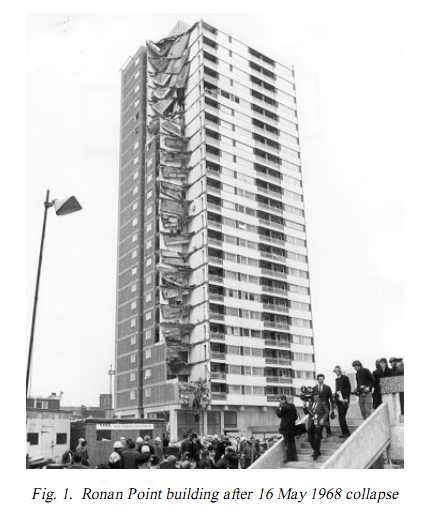Blast and Progressive Collapse

R. Shankar Nair, Ph.D., P.E., S.E. is a principal and senior vice president of Teng & Associates, Inc. in Chicago. In a career that has focused on structural design of large architectural and civil engineering projects, he has developed the structural concepts for numerous tall buildings and many major bridges. This work has received numerous awards, including four AISC/NSBA “Prize Bridge” awards and six Structural Engineers Association of Illinois annual “Most Innovative Structure” awards. Also active as a researcher and leader of professional activities, he has served as chairman of the Council on Tall Buildings and Urban Habitat and is, at present, a member of the AISC Specification Committee and chairman of its Stability Task Committee.
ABSTRACT Progressive collapse is the collapse of all or a large part of a structure precipitated by damage or
failure of a relatively small part of it. The phenomenon is of particular concern since progressive collapse is often (though not always) disproportionate, i.e., the collapse is out of proportion to the event that triggers it. Thus, in structures susceptible to progressive collapse, small events can have catastrophic consequences.
After the progressive and disproportionate collapse of the Ronan Point apartment tower in England in 1968, prevention of progressive collapse became one of the unchallenged imperatives in structural engineering, and code-writing bodies and governmental user agencies attempted to develop design guidelines and criteria that would reduce or eliminate the susceptibility of buildings to this form of failure. These efforts tended to focus on improving redundancy and alternate load paths, to ensure that loss of any single component would not lead to a general collapse. But in fact, redundancy is only one of the ways of reducing susceptibility to disproportionate collapse. Improved local resistance for critical components and improved continuity and interconnection throughout the structure (which can improve both redundancy and local resistance) can be more effective than increased redundancy in many instances. Through an appropriate combination of improved redundancy, local resistance and interconnection, it should be possible to greatly reduce the susceptibility of buildings to disproportionate collapse.
INTRODUCTION
On the morning of 16 May 1968, Mrs. Ivy Hodge, a tenant on the 18th floor of the 22-story Ronan Point apartment tower in Newham, east London, struck a match in her kitchen. The match set off a gas explosion that knocked out load-bearing precast concrete panels near the corner of the building. The loss of support at the 18th floor caused the floors above to collapse. The impact of these collapsing floors set off a chain reaction of collapses all the way to the ground. The ultimate result can be seen in Figure 1: the corner bay of the building has collapsed from top to bottom. Mrs. Hodge survived but four others died.

Fig. 1. Ronan Point building after 16 May 1968 collapse
While the failure of the Ronan Point structure was not one of the larger building disasters of recent years, it was particularly shocking in that the magnitude of the collapse was completely out of proportion to the triggering event. This type of sequential, one-thing-leading-to-another failure was labeled “progressive collapse” and the engineering community and public regulatory agencies resolved to change the practice of building design to prevent the recurrence of such tragedies.
Download
http://s18.alxa.net/s18/srvs2/01/Bla...e.Collapse.rar